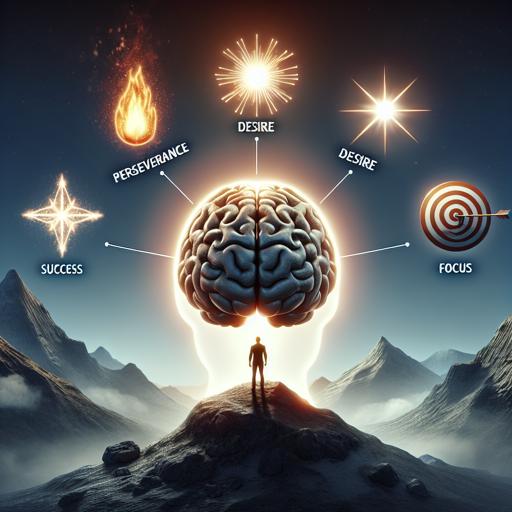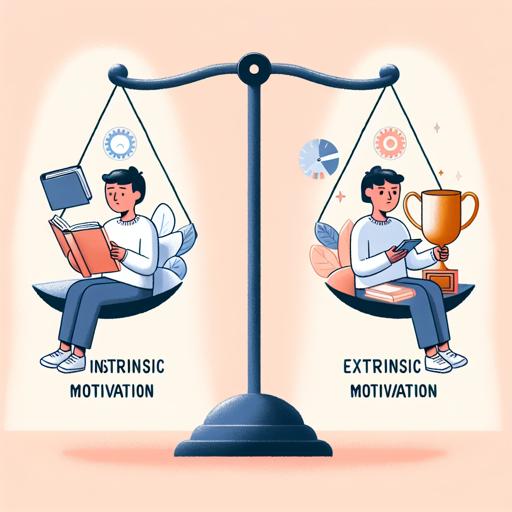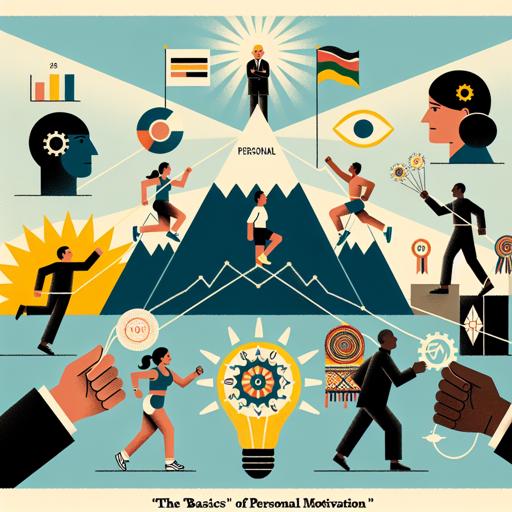Understanding personal motivation is a journey into the core of what drives us to pursue our goals and dreams. At its essence, personal motivation is the internal force that propels us to take action, whether it’s in our careers, hobbies, or personal lives. This intrinsic drive is shaped by our desires, values, and aspirations, and understanding it can unlock the potential for greater achievements and fulfillment.
In this blog, we will delve into the basics of personal motivation, exploring the factors that influence it and offering insights into how you can harness this powerful force to enhance your life and reach your fullest potential.
The psychology behind personal motivation

Unraveling the enigma of what fuels our drive can be as captivating as a plot twist in a well-crafted novel. At the heart of understanding personal motivation lies a complex interplay of psychological elements that shape our ambitions, influence our behaviors, and ultimately determine our successes or failures. Motivation is not a one-size-fits-all endeavor; it’s an intricate mosaic composed of intrinsic desires and extrinsic incentives.
Much like the gears within a finely-tuned watch, each element plays a pivotal role, harmonizing to propel us forward. Within the labyrinthine corridors of our minds, motivation finds its genesis—in the goals we set, the self-efficacy we build, and the values we hold dear.
By dissecting these components, one can begin to demystify the processes that guide everyday decisions and life-altering moments alike. Consider the satisfaction derived from completing a marathon after months of arduous training. It’s less about the finisher’s medal and more about the internal sense of achievement that catalyzed each step of the journey.
This intrinsic motivator typifies personal motivation’s foundational principles, where fulfillment is drawn from the activity itself rather than any external reward. On the flip side, extrinsic motivation might spur an individual to endure a monotonous task for the promise of financial gain or social recognition.
Understanding personal motivation in this context involves striking an equilibrium between these driving forces, fostering environments where intrinsic motivations thrive while recognizing the utility of extrinsic rewards. Navigating the psychological underpinnings of motivation also requires an acknowledgment of self-regulation and resilience. Motivation isn’t static; it ebbs and flows, influenced by our emotions, cognition, and social interactions.
Developing personal motivation can sometimes demand a clever restructuring of one’s mindset, turning perceived obstacles into opportunities for growth. This dynamic change transforms the proverbial bumps in the road into stepping stones.
By leveraging self-reflection and proactive goal-setting, individuals can harness their potential, maintaining momentum even when faced with adversity. Ultimately, understanding the basics of what gears our motivation fortifies a deeper comprehension of the self, paving the way for greater personal and professional fulfillment.
Identifying your intrinsic and extrinsic motivators

In the vast landscape of human experience, motivation operates as the unseen engine that drives our choices, goals, and achievements. The trip through understanding personal motivation reveals two principal co-pilots: intrinsic and extrinsic motivators. Intrinsic motivators are the internal forces fueled by personal satisfaction, curiosity, or the inherent joy of a task.
Like a child captivated by the endless possibilities of a cardboard box, these motivators thrive on the sheer delight of participation. Consider the artist who loses herself in the canvas, painting not for acclaim but for the pure euphoria of creativity unleashed.
This inner motivation beckons with a sense of personal fulfillment that transcends external validation. Extrinsic motivators, in contrast, are the tangible rewards or pressures that life throws our way to prod us into action. They encompass everything from monetary gain and accolades to the proverbial carrot on a stick.
Imagine an employee striving for a bonus—not because they yearn for the thrill of filing spreadsheets, but for that end-of-year trip to the Maldives. Yet, this doesn’t render extrinsic motivators inferior; they cater to our pragmatic sides, offering compelling reasons to pursue tasks that might not initially spark joy.
Mastering the art of balancing these motivators is akin to a symphony conductor orchestrating harmonious melodies from diverse instruments. Understanding where each motivator fits in your personal dynamics doesn’t just enrich your inner world; it equips you with the clarity to navigate life’s ambitions with intentionality, ensuring that your goals are both personally meaningful and practically rewarding.
The role of goal setting in enhancing motivation

Picture the pursuit of a goal as a dynamic tango between ambition and ability, a dance where the rhythm is set by one’s understanding of personal motivation: the basics of what drives us forward and how we orchestrate our steps. The effortless glide across the dance floor of achievement often hinges upon the subtleties of goal setting.
It transforms abstract aspirations into tangible, strategic targets. The process is akin to setting a compass needle toward a desired destination, empowering us with the clarity and direction necessary for meaningful progress. Goal setting breathes life into motivation by offering a framework that encourages perseverance through adversity, much like a seasoned partner guiding each step of the tango with grace and precision.
Diving deeper into the psychology of this dance, goal setting caters to our intrinsic need for autonomy, competence, and relatedness—core pillars in understanding personal motivation. These objectives provide a sense of ownership and control over our actions, cultivating an environment where motivation can flourish. For instance, when faced with the mammoth task of writing a novel, breaking the endeavor into digestible chunks—such as drafting one chapter per month—can transform a formidable mountain into a series of manageable hills.
Each completed chapter becomes a milestone, reinforcing competence and stoking the motivational embers to tackle subsequent challenges with renewed vigor. Anchoring motivation with well-structured goals also serves to ward off the specter of procrastination, a notorious saboteur of aspirations.
Clear objectives act as beacons, illuminating a path through the fog of indecisiveness and inaction. By setting specific, measurable, attainable, relevant, and time-bound objectives, we arm ourselves with a strategy finely tuned to repel stagnation and ignite a persistent drive toward achievement.
Thus, the art of goal setting not only enhances motivation but also sculpts our journey, ensuring each step is as deliberate and purposeful as a perfectly executed tango move across the stage of personal growth.
Overcoming common barriers to personal motivation
Navigating the intricate labyrinth of personal motivation requires more than just a spirited pep talk or a flurry of inspirational quotes. At its core, understanding what makes each of us tick involves an exploration as nuanced as a perfectly composed orchestra. Personal motivation, that elusive force fueling both our aspirations and daily endeavors, can often feel like a mysterious alchemy of desire, purpose, and persistence.
Yet, many find themselves stalled by familiar obstacles that seem to zap their enthusiasm or undermine their commitment. Overcoming these hurdles involves a conscious understanding of what initiates our drive and the psychological principles that sustain it.
Whether it’s the paralyzing fear of failure, the uncertain steps of self-doubt, or the seemingly insurmountable mountain of procrastination standing in our way, these barriers can be systematically dismantled with a clearer grasp of motivational mechanics. The foundation of vanquishing these barriers lies in comprehending your own motivational blueprint.
Consider motivation as a cocktail of intrinsic and extrinsic incentives, each playing its own role in the broader tapestry of why you act, create, or strive. Intrinsic motivation thrives on a genuine passion or curiosity about a task, like the scientist engulfed in the sheer joy of discovery or the artist lost in their creation. Extrinsic motivators, on the other hand, often involve tangible rewards or recognition, like the prospect of a promotion or the allure of applause.
Both can be powerfully compelling, yet the delicate balance between them dictates the longevity and quality of our motivation. Over time, honing the art of aligning your goals with internal values and external rewards can transform the motivations that drive a transient sprint into those that fuel a lifelong marathon.
To conquer the common barriers that beset personal motivation, one must foster an environment conducive to both types of motivation. Craft a space where failures are reframed as stepping stones to wisdom rather than walls of defeat. Channel your inner toddler, embracing curiosity and resilience as you would during the endless falls and rises when learning to walk.
Cultivating a growth mindset can become the cardinal shield against challenges, where the focus shifts from immutable shortcomings to the promise of potential. Additionally, make room for periodic reflections, allowing for recalibration of your aspirations and adjustments in your methods to keep that motivational flame alive. Thus, understanding personal motivation doesn’t just stop at knowing what propels you forward; it encompasses devising a strategy that keeps you marching resolutely on the unending journey of self-improvement.
Strategies for sustaining long-term motivation
Delving into the labyrinthine psychology of personal motivation can feel like wrestling with an invisible octopus—full of unexpected maneuvers and precarious shifts. Yet, at the heart of this intricate dance lies the simple truth that understanding what fuels your unique drive is pivotal for long-term success.
The journey begins by recognizing that motivation isn’t a one-size-fits-all construct; it’s the unique tapestry woven from threads of aspirations, desires, and even fears that keep the engine of ambition humming. Consider it the art of decoding your motivational DNA, where personal goals serve as stars that guide the celestial map of your journey. The foundation of sustaining long-term engagement with one’s objectives is in harnessing intrinsic motivation.
This stems from the sheer joy, satisfaction, and ongoing interest in the activity itself rather than external rewards. Imagine a seasoned artist who paints not for fame or fortune but simply because the act of painting is as essential as breathing. Equipping oneself with this intrinsic enthusiasm ensures that when the external wind of rewards dries up, the internal fire continues to burn brightly.
To achieve this, it is crucial to align activities with personal values and passions while allowing for growth, creativity, and autonomy. For those seeking a strategic plan for enduring inspiration, blending intrinsic motivation with realistic extrinsic goals comes highly recommended.
Picture a budding writer penning chapters with the same fervor and dedication, driven by both the desire to create something meaningful and the prospect of publishing success. By setting specific, achievable milestones and allowing yourself to celebrate small victories along the way, you forge a motivational feedback loop.
This delicate balance between internal passion and external incentives forms a robust foundation, creating a resilient framework that supports long-term success. And so, by decoding what personally motivates us, we lay the groundwork for a sustainable journey towards our aspirations, equipping ourselves with tools to face any motivational ebbs.
Nasza rekomendacja wideo
Podsumowanie
Understanding personal motivation is essential for personal growth and achieving goals. It involves recognizing intrinsic and extrinsic motivators and how they influence behavior.
By identifying what drives you, you can harness these motivations to enhance productivity and satisfaction. This understanding allows for setting realistic goals, overcoming obstacles, and maintaining focus, ultimately leading to a more fulfilling and successful life.
Najczęściej zadawane pytania
What are the key factors that influence personal motivation, and how do they vary from person to person?
Key factors influencing personal motivation include intrinsic interests, external rewards, personal goals, and social influences, and they vary from person to person based on individual values, experiences, and psychological needs.
Of course! Please provide the question you’d like me to answer.
How can understanding one’s intrinsic and extrinsic motivators improve personal and professional growth?
Understanding one’s intrinsic and extrinsic motivators can enhance personal and professional growth by aligning actions with personal values and external rewards, leading to increased satisfaction and productivity.
Sure, please provide the question you’d like answered.
What role do goals and aspirations play in shaping an individual’s motivation?
Goals and aspirations serve as a driving force that directs an individual’s efforts and energy, providing purpose and motivation to achieve desired outcomes.
Sure, please provide the question you’d like me to answer.
How can self-reflection and self-awareness contribute to a deeper understanding of personal motivation?
Self-reflection and self-awareness enable individuals to identify their core values, desires, and emotions, thereby clarifying the underlying motivations that drive their actions and decisions.
Of course! Please provide the question you’d like me to answer.
What strategies can be employed to maintain motivation during challenging times or when facing setbacks?
To maintain motivation during challenging times or setbacks, one can set clear, achievable goals, practice self-compassion, seek support from others, and focus on the progress made rather than solely on the outcome.
Sure, please provide the question you’d like me to answer.
How does the concept of motivation differ across cultures, and what can we learn from these differences to enhance our own motivational strategies?
The concept of motivation differs across cultures in terms of values, goals, and social influences, and by understanding these differences, we can tailor our motivational strategies to be more inclusive and effective by incorporating diverse perspectives and approaches.
